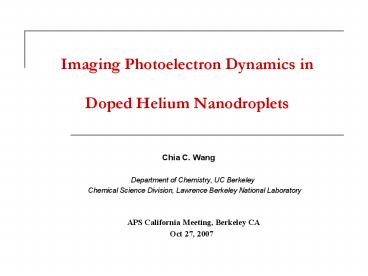Imaging Photoelectron Dynamics in Doped Helium Nanodroplets - PowerPoint PPT Presentation
1 / 21
Title:
Imaging Photoelectron Dynamics in Doped Helium Nanodroplets
Description:
Undergoes ?- transition at 2.18 K, exhibiting superfluidity ... Ti:Sapphire oscillator, ~80MHz. Repetition rate: 1-3 kHz. Pulse duration: 25 fs ... – PowerPoint PPT presentation
Number of Views:44
Avg rating:3.0/5.0
Title: Imaging Photoelectron Dynamics in Doped Helium Nanodroplets
1
Imaging Photoelectron Dynamics in Doped Helium
Nanodroplets
- Chia C. Wang
- Department of Chemistry, UC Berkeley
- Chemical Science Division, Lawrence
Berkeley National Laboratory - APS California Meeting, Berkeley CA
- Oct 27, 2007
2
Helium
- Helios, God of light, discovered in 1868
- The second abundant element in universe
- The only substance remains liquid at almost 0 K
- Undergoes ?- transition at 2.18 K, exhibiting
superfluidity
3
Helium Nanodroplets
- Physical properties
- Helium clusters with 102 108 atoms
- nm scale
- Ultracold 0.37 K
- Finite-sized Superfluid gt 64 atoms
- Capability to dope foreign species
- General applications
- As an ideal spectroscopic medium
- As a platform to stablize transient species,
and to fabricate unusual complex
J. Peter Toennies, Andrey F. Vilesov Angew.
Chem. Int. Ed. 43, 2622 (2004).
4
Helium Droplets Project at LBNL
- Goal To understand the coupling between charged
particles and He droplets - - How are photoelectrons generated
inside the droplets ? - direct or indirect? - - How is the ejected photoelectron
affected by He droplets? e-He coupling ? - - How does the electron transport in
the superfluid He droplets? any energy
dissipation? - Approach Photoionization
5
Helium Droplets Machine
- Excitation scheme
- - VUV synchrotron radiation
- - or, UV laser
- - or, XUV (under construction)
- Detection method
- - Photoelectron imaging
- - Photofragment imaging
- - Time-of-Flight Mass Spectrometry
6
VUV Photoionization By Synchrotron Radiation
Beamline 9.0.2 at Advanced Light Source
- High intensity
- Tunability
- Single photon process
7
Photoelectron spectrum of Xe doped in Helium
droplets
Ultraslow e-
Xe in vacuum, 21.6 eV
Xe in droplets, 21.6 eV
broad feature
Xe in droplets, 20.6 eV
Photoelectron Kinetic Energy
(eV)
8
Penning Ionization via Excitation Energy Transfer
He Droplets 2p state
atomic He 2p
- He 2p (1s2p 1P) state
- - 21.2 eV (atomic He)
- - 21.6 eV (He droplets)
3p
4p
5p
N 1750
Total Ion Yield KrHen
N 550
N 200
N 120
N 50
Excitation Energy (eV)
M. Joppien, R. Karnbach, and T. Moller, Phys.
Rev. Lett. 71 (16), 2654 (1993)
J. H. Kim, D. S. Peterka, C. C. Wang, and D. M.
Neumark, J. Chem. Phys. 124 (21) (2006).
9
PES of Xe doped in various sized He droplets at
21.6 eV
10
Destiny of excited He droplets at 1P state
- Transfer excitation to foreign species
- Decay to lower excited state
- 2p 3P0,1,2, 2s 1S0, 2s 3S1 states
- Fluorescence
11
Competition of excitation transfer between 1P1
and 1S0 state
- indirect pathways more efficient
- - He atoms act as antenna
- decaying to 1S state
- compete with excitation transfer
- Dipole-dipole hopping transfer
12
Post ionization dynamics
- Electron transport and escape
- Energy dissipation?
- Formation of electron bubble ?
- Electron-ion recombination effect ?
e
13
Photoelectron relaxation in the droplet
- Broad feature shows
- Strong Helium droplets size dependence
- Independence of dopant species and
- pickup cell pressure
- Maximum shifts to higher eKE as increasing
size - A cut-off edge shows clearly at largest
droplets
Photoelectron Kinetic Energy
(eV)
14
Freedom isnt free !
- Minimum energy required to move freely in He
droplets
He droplets radius (Å)
15
Across the borderline
- A barrier caused by the Coulomb interaction near
the interface - Responsible for the appearance of ultraslow
electrons - (observed in both pure and doped He
droplets)
Crandall and Williams, Phys. Rev. A., 5, 2183
(1972)
Pure 0.6 meV
Kr doped 1.0 meV
Xe doped 1.6 meV
eKE (meV)
eKE (meV)
eKE (meV)
16
Coming soon Ultrafast XUV Photoelectron
Imaging of He droplets
17
Acknowledgements
- Prof. Daniel M. Neumark
- Dr. Darcy S. Peterka
- Dr. Jeong Hyun Kim
- Dr. Musa Ahmed
- Dr. Oleg Kornilov
- Dr. Oliver Gessner
-
18
TOF- MS of Kr and Xe doped helium droplets
- Photon energy dependence -
Xe (a) 21.6 eV
Kr (a) 21.6 eV
(b) 22.75 eV
(b) 22.8 eV
(c) 25.5 eV
(c) 25.5 eV
Jeong Hyun Kim, Darcy Peterka, Chia Wang and
Daniel Neumark J. Chem. Phys. 124, 214301
(2006).
Mass (amu)
19
At 21.6 eV - Excitation Transfer Rules !
Ne
Ar
Kr
Xe
20
Formation of Helium Droplets
Droplet Temperature
J. Peter Toennies, Andrey F. Vilesov Angew.
Chem. Int. Ed. 43, 2622 (2004).
Nozzle Temperature
J. Harms, M. Hartmann, B. Sartakov, J. P.
Toennies, and A. F. Vilesov, J. Chem Phys 110
(11), 5124 (1999).
21
Picking-up dopants of interest
- He droplets passes through a pick-up cell
- containing 10-6 - 10-5 torr of the species
- Probability for picking up k particles
- is given by Poisson distribution
- Pk(z) (Z)k / k! exp(-Z)
- Z average number of collision
















![[Step-by-Step Guide] Configure Document Generation Functionality in MS Dynamics 365 PowerPoint PPT Presentation](https://s3.amazonaws.com/images.powershow.com/9013709.th0.jpg?_=20180307081)














